#Codfish Potato Bake
Explore tagged Tumblr posts
Text
Cuisine de Provence
If you want to add a generous bit of sunshine to your meals, then I suggest trying your hand at la Cuisine de Provence. Fragrant with herbs like thyme, rosemary or basil, colourful with fresh vegetables, these recipes celebrate the fish and seafood of the French Riviera and the quality meat of l'arrière-pays! As I am spending a week's holiday in Provence, I intend to enjoy everything la Côte d'Azur has to offer, from bathing in the Mediterranean Sea to the delicious gastronomy! Try these recipes, if you want to follow me!
Drinks
Pastis
Limoncello Spritz
Lavender Liqueur
Appetizers
Rouille
Anchoïade
Parmesan Aïoli
Green Olive Tapenade
Aïoli
Baguettes
Roasted Garlic, Thyme, Olive and Tomato Plait
Entrées
Garden Pistou Soup (Vegan)
Salade Niçoise
Provençal Roasted Chicken
Meat
Provençal Burger
Niçoise Stuffed Zucchini
Fish
Prawn Pasta à la Marseillaise
Anchovy Stuffed Courgettes
Rosemary Roasted Tuna
Brandade de Morue (Codfish Potato Bake)
Sage and Lemon Sardines
Red Mullet and Aubergine Burgers
Rosemary and Basil Sardines
Roasted Sardines
Sides
Poêlée Provençale (Sautéed Aubergines and Peppers)
Tian (Vegan)
Tomatoes Provençal
Ratatouille
Savoury Pies and Tarts
Tourte aux Blettes
Condiments
Herbes de Provence
Desserts
Lavender Apricot Tart
Peach and Apricot Charlotte
Ice Cream
Lavender Ice Cream
Lavender Apricot Sorbet (Vegan)
Lavender Apricot Ice Cream Cups
#Recipes#Recipe#Recipe List#Cuisine de Provence#Cuisine de Provence Recipe List#Cuisine de Provence Recipes#Provençal Cuisine#Cuisine Provençale#Provencal Kitchen#Regional Cuisine#French Cuisine#Provence#Côte d'Azur#French Riviera#South of France#Southern France#Travel and Food#Travel Tuesday#Recipe Box#Summer#Summer recipe#Summertime#Holiday
10 notes
·
View notes
Text
first made oven baked codfish with butternut pumpkin cream and mashed potatoes on saturday, then risotto with the roasted leftover pumpkin, carrots and sweet potato. the orange weekend
4 notes
·
View notes
Text
Italian Christmas Traditions | What Christmas Traditions Does Italy Bring Into Their Homes?
A Celebration of Italian Christmas Traditions
Christmas is the best time for family, friends, and celebration. It’s a time when we come together to enjoy each other’s company and exchange gifts. For many people, Christmas is a time to celebrate their cultural heritage. In Italy, Christmas is celebrated in a very special way.
If your first Christmas is spent in Italy, you’re about to experience a wonderful time of year when the celebrations are nothing short of extraordinary! You’ll indulge in delectable delicacies and savoury cuisines that make up Italian Christmas traditions.
Get ready for an incredible cultural journey full of folklore and feasts with all the locals. Continue reading on how to celebrate like an Italian this holiday season and relish every bite of traditional Italian food!
Be Prepared for a Whole Month of Festivities
For Italians, Christmas is not just a single night of celebration. Rather, the festivities begin four Sundays before Christmas and last until Epiphany on January 6th. Each Sunday leading up to the big day is celebrated with its traditions.
Commencing with the Day of Immaculate Conception on December 8th, this Catholic festival commemorates the conception of the Virgin Mary without sin as she was immaculately conceived. Even though it is a spiritual observance, numerous households will use this holiday to gather and begin decorating their Christmas trees.
Christmas decorations in Italy are handmade and generally include some of the eight traditional figures known as ‘presepi’. These presepi are nativity scenes constructed out of clay, paper-mâché, or wood that represent the arrival of Jesus in Bethlehem.
Vigilia di Natale (Christmas Eve)
Vigilia di Natale is one of the most celebrated events in Italy. Families will share a lavish seafood dinner and abstain from eating meat on this day. This tradition is known as ‘La Vigilia‘ or ‘The Vigil’.
The feast usually consists of octopus salad, grilled squid, stuffed mussels, smoked salmon, and baccalà (salted codfish). The meal’s centrepiece is a fish dish with potatoes, garlic, and olive oil. Dessert typically consists of torrone (nougat) and panettone (a sweet bread made with raisins).
After dinner, families exchange gifts, followed by a midnight mass known as ‘La Messa della Notte’. Churches will hold Christmas services at midnight, and many Italians attend the service wearing new clothes that were gifted to them earlier in the evening.
Christmas Day (Natale) and Beyond
The 25th is a day of immense joy for Italians as they congregate around the dinner table with their families and indulge in delicious festive food and is known as Natale. The festivities carry on until late into the night while playing board games and unwrapping presents — it’s an unforgettable experience!
Italian families gather to share an unforgettable culinary experience far beyond lunch on this day! From savoury dishes to sweet treats and mouthwatering desserts, no expense is spared for this traditional spread which can include up to a dozen scrumptious courses.
The Italian Christmas banquet is as delicious and mouthwatering as it sounds; you’ll be served a delightful selection of cured meats, cheeses, frittata and baked al forno pasta. As the main course arrives on your plate- think pork, beef or lamb accompanied by veggies such as green beans, carrots, roasted potatoes and parsnips – you can rest assured in knowing that gastronomic pleasure awaits!
Stephen’s (Santo Stefano) Day
On December 26th, Italians celebrate ‘Santo Stefano’ as a second Christmas Day. People indulge in exchanging gifts and having large family dinners to commemorate the occasion. This day is meant to enjoy quality time with your loved ones while feasting delicious leftovers!
While each Italian town’s celebration may differ, the spirit of festivity and generosity remains consistent. For instance, some towns will parade in tribute to St Stephen, while other communities might choose a more subdued approach by donating to local hospitals.
Visiting the re-enactments of the nativity scene in Italian towns, such as Fara San Martino, located in Abruzzese mountain town, is also a popular activity on this day. Locals gather on its main piazza to commemorate and celebrate this time-honoured tradition.
Epiphany (Festa dell’Epifania)
Finally, the festivities close with Epiphany (Festa dell’Epifania) on January 6th. Also known as ‘La Befana’, this holiday commemorates the Three Wise Men’s visit to Jesus.
During the night, children keep their shoes by the fireplace and await ‘La Befana’ – a witch-like figure who flies around on her broomstick and delivers presents to good children. Sweets such as torrone and panettone are usually left in the shoes for them to enjoy.
In conclusion, Italian Christmas traditions offer a rich tapestry of culture and gastronomy. From Vigilia di Natale to Epiphany, Italians take immense pride in preserving their customs and celebrating the birth of Jesus with their families. We hope you have enjoyed our brief tour of Italian Christmas traditions!
source https://sesamorestaurant.com/news/italian-christmas-traditions-what-christmas-traditions-does-italy-bring-into-their-homes/ from Sesamo https://sesamorestaurant.blogspot.com/2022/12/italian-christmas-traditions-what.html
0 notes
Note
1 / What faith is this character? Do they celebrate Christmas, and if so, how much do they take the religious element of Christmas to heart? Does this character celebrate any other religious holidays during the festive season?
2 / What does this character eat on Christmas Day? What is their favourite festive food? Their least favourite?
Thanks for ask!!
If you want ask, click there
⛪️ - What faith is this character? Do they celebrate Christmas, and if so, how much do they take the religious element of Christmas to heart? Does this character celebrate any other religious holidays during the festive season?
Isolde is catholic, but she isn't a greater devotee like her mother. Yes, she celebrates the X-mas. The most representative religious elements that Isolde uses is the Christmas Birth (she likes put under the tree, with the Mary, Joseph, the Jesus Child, the Archangel, the Three Wise Men and many animals. Talbott helps with the vegetation and applies "Herbivicus" to the poinsettias); the Carols songs, the posadas (but only the nearest to Christmas Eve) and breaks the Piñata (it's a representative of The Seven Sins):
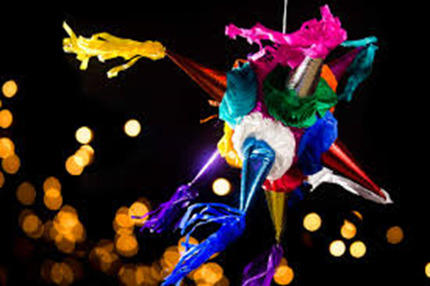
Isolde doesn't like to go to the church (thanks for her mother), but every Christmas gives the thanks for all, in special for her family (Talbott and their kids) and her friends are safe and her side. By the way, Isolde does The Guadalupe-Reyes Marathón. In The Three Kings Day (January 6th) she bakes rosca de reyes, makes hot cocoa and sometimes, sweet tamales (usually chocolate or guayaba flavor).
Since Talbott and Isolde have children, they give them gifts in January 6th like in Christmas, too.

🍽 - What does this character eat on Christmas Eve and Christmas Day? What is their favourite festive food? Their least favourite?
In Hogwarts, she hadn't many options than the traditional british dishes. She didn't have trouble (except with the Brussels sprouts salad, she hates them), but sometimes missed the mexican dishes.
But since she moved in with Talbott, they interspersed what eat in Christmas Eve and News Year Eve. Both cook in those days together:
The beverage: Fruits Punch with piloncillo/panela

A warm drink of guayaba, tamarindo, cinnamon, tejocotes, sugar cane, raisins, prunes, apples green and yellow with a shot of ron, sweetened with piloncillo/panela. This drink is a mandatory in Christmas and News Year Eve.
Food entrance: Elbow soup with cream, jam and bell pepper.
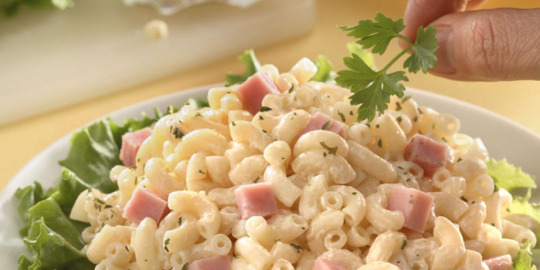
It's one of her favorites. But if they cook it in Christmas Eve; in News year Eve they eat spaghetti alla bolognese or cream soup (pumpkin, corn or poblano pepper), and vice versa.
Main course: Turkey or Christmas Romeritos

Isolde's favorite recipe for turkey is with a nut sauce (nogada) with a sweet stuffing ground beef with nuts.
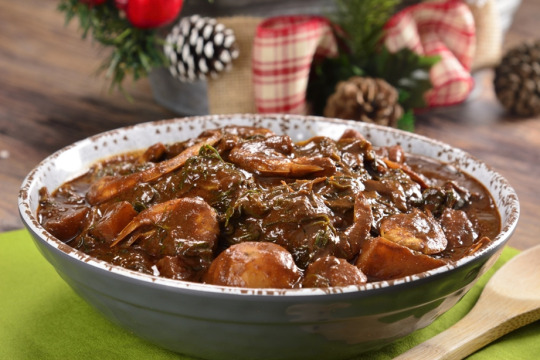
Romeritos, by other hand, is a dish with shrimp, cambray potatoes, romeritos and poblano mole. She loves the mix of spicy and sweet flavor of the mole, usually she eats with bread. Isolde cooks it in Lent season, too.
Dessert: British Christmas pudding or Rice pudding

Like Talbott, Isolde is a sweet tooth. And they can't forget the dessert. sometimes Isolde cooks the classic X-mas pudding; in others, her favorite, Rice pudding:
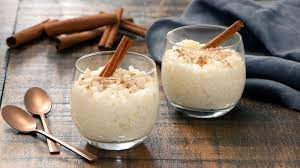
Her least favorite is a spanish dish, but in Mexico usually the people eat it in this season: Basque Style Codfish Stew. She doesn't like codfish and dislike the salty flavor and olives. And the making is lately, because the coldfish has put in water for days.

#isolde hiwatari#talbott winger#harry potter hogwarts mystery#hogwarts mystery#talbott x mc#talbott x jacob's sibling#talbott winger x mc#hphm mc#hphm#hphm christmas#ask game#talbott x isolde
11 notes
·
View notes
Photo

Enjoy life, it’s delicious! 😋 Come by The Hainan Story Chapter 2 which will be opening on 7th July 2022, offering both Singaporean and Hainanese specialties across new and old brands to become the go-to destination for tourists and locals. The Hainan Story Chapter 2 will retain signature brands like Newspaper Curry Rice, Wee Nam Kee Chicken Rice and Uncle Robert Western & BBQ. 218 Hainanese Lor Mee and Ah Mai Kum Hainanese Chicken Rice Porridge will also be included to make The Hainan Story Chapter 2 the go-to place for tourists and locals alike to grab local souvenirs, gifts and meals at Jewel Changi Airport. An extension of The Hainan Story Bakery will also be included, with additions such as cream horns and Asian-inspired chocolate pralines made to its lineup of fresh bakes and Swiss rolls. Featured dishes: 🍜 Authentic Jiaji White Braised Duck Hainanese Lor Mee (S$16.80) 🍜 Chapter 2 Gourmet Hainanese 'Fen Pi' Laksa (S$14.80) 🐓 Chapter 2 1980’s Hainanese Chicken Cutlet coat with Potato Chips Crumbs (S$18.80) 🐓 Signature Hainanese Curry Chicken Pot Pie (S$13.80) 🐓 Hainanese Grandma's Golden Fried Chicken Wing (S$9.90/4pcs) 🐙 Hainanese Father in law Banana Leaf Sambal Grilled Sotong (S$21.80) 🦐 Hainanese Father in law Banana Leaf Sambal Grilled Jumbo Tiger Prawn (6pcs) (S$23.80) 🥗 Ice Plant Summer Fruit Rojak with Crispy Codfish (S$16.80) 🍲 Chapter 2 Old English Oxtail Stew (S$25.80) 🍞 Hainanese Curry Chicken Sourdough Bomb (S$19.80) 🥣 Signature Hainanese Chicken Rice Porridge (S$11.80) 📍The Hainan Story Chapter 2 78 Airport Boulevard # B2-201/202 Jewel Changi Airport Singapore 819666 🕗 Mondays to Sundays: 8am to 10pm (at Jewel Changi Airport) https://www.instagram.com/p/Cfq_WRjBHJA/?igshid=NGJjMDIxMWI=
0 notes
Text
Nampō Roku, Book 2 (13b): (1587) Twelfth Month, Sixteenth Day, After the Morning Meal, Part 2.

13b) After [chanoyu in the small room] was finished, [Hideyoshi] deigned to go out into the shoin; [and] Oshō took his leave¹.
▵ Shiru tsuru [汁 鶴]².
▵ Namasu [鱠]³.
▵ Ni-mono hara-hara kou imo [煮物 ハラ〰 コホウ イモ]⁴.
▵ Ni-no-shiru tara [二ノ汁 鱈]⁵.
▵ Kawarake ko-tori [カハラケ 小鳥]⁶.
▵ Ae-mono uto [アヘモノ ウト]⁷.
▵ Sashimi koi ・ mana-katsuo [サシミ 鯉 ・ マナカツホ]⁸.
▵ Kō-no-mono [香物]⁹.
▵ O-sakana tairaki ・ uzura [御肴 タイラキ ・ ウツラ]¹⁰.
▵ Hasu [ハス]¹¹.
▵ Suimono hashira ・ ko-kabu [吸物 ハシラ 小カフ]¹².
▵ Kashi kan ・ senbei ・ zakuro ・ ko-neri ・ nashi [菓子 カン ・ センヘイ ・ サクロ ・ 小ネリ ・ ナシ]¹³.
[In the] toko [床]¹⁴
◦ A pair of landscape paintings by Ba En [馬遠]¹⁵.
◦ Sai-kōro [豺香爐], [displayed] on a guri-guri kō-dai [クリ〰香臺]¹⁶.
[On the] shoin-doko [書院床]¹⁷ ◦ [子昂 硯]; ◦ [龜水入]; ◦ [筆架]; ◦ [筆 ・ 墨]; ◦ [子昂 軸物]¹⁸.
[On the] chigae-dana [チカヘ棚]¹⁹ ◦ jikirō [食籠]²⁰; ◦ bon-san Kiji [盆山 紀路]²¹.
[Hideyoshi] expressed his desire for the daisu to be arranged, and he made tea [with his own hands] using a taikai²².
_________________________
¹Migi sugite shoin [h]e oide-nasare, uma-no-toki o-zen deru, Oshō ha o-kaeru [右過テ書院ヘ御出被成、午時御膳出ル、和尚ハ御歸].
Migi sugite [右過テ] means “after the preceding was finished....”

The details of Rikyū's shoin during this period are unclear. All that seems to be known with any certainty is that it had a 6-mat jō-dan [上段]. The above is a reconstruction based on the shoin in the Hisada family's residence* (however, the Hisada shoin had a 4-mat jōdan, rather than one of six mats). At any rate, this will give the reader at least a general understanding of the nature of the room in question. (Note that the 6-mat area at the top of the sketch is the jō-dan, in which a 2-mat area, in the upper left-hand corner, was raised still higher as the seat for the nobleman: the dashi-fu-zukue is appended to that part of the room, and it was there that the hand-scroll of Chinese poems was displayed -- together with Sugō‘s writing implements.)
Oide-nasare [御出被成] is a polite form meaning that Hideyoshi (and the others) moved on to the shoin.
Uma-no-toki [午時] means “at the hour of the Horse,” in other words, in the noon hour. Given the amount of food that was served, there likely was a certain delay, during which the guests inspected the objects that Rikyū had placed on display in the toko, and on tsuke-shoin and chigai-dana.
Oshō ha o-kaeru [和尚ハ御歸]: as mentioned in the previous post, Kokei Sōchin probably excused himself after the inspection because he did not care to participate in the banquet that would follow (which would naturally include fish and fowl, and drinking as well). This early departure would have been accepted by Hideyoshi without any ill feeling.
With respect to the kane-wari of this arrangement, the two kakemono and kōro count for three units, and so are han [半]. The writing implements count as a single unit (since they are grouped together, as shown in the sketch), while the hand-scroll of Chinese poetry is separate†, giving the dashi-fu-zukue a value of two, which is chō [調]. And the jikiro and bon-san arranged on and below the chigai-dana count for two units, and so the tana is also chō [調]. Han + chō + chō is han, as is suitable for the latter part of a chakai held during the daytime. __________ *The Hisada family descended from one of Rikyū’s daughters, and seems to have actively tried to preserve Rikyū‘s legacy in details such as this.
†Tanaka Senshō said that he believed that the hand-scroll of poems was displayed on the chigai-dana, rather than the dashi-fu-zukue. While this disagrees with the way Rikyū has formatted the entry, it has no bearing on the total count, so far as kane-wari is concerned.
²Shiru tsuru [汁 鶴].
The first bowl of soup (probably a clear soup) contained crane.
Crane (and other large birds, such as swan and wild goose) were occasionally taken by Hideyoshi's hawkers (hawking was enjoyed by Hideyoshi and his court), and then prepared and served at court banquets -- as well as during chakai held within the palace complex when the fowl were available, as a sort of special treat.
Soup was made by boiling the bones, while the meat was usually mashed and formed into dango [團子] (meatballs), which were cooked in the broth along with pieces of daikon, mushrooms, and other seasonal vegetables.
³Namasu [鱠].
Namasu is a sort of salad, made from julienned daikon and carrot, served raw, dressed with a mixture of rice vinegar, soy sauce, and mirin.
⁴Ni-mono hara-hara gobō imo [煮物 ハラ〰 コホウ イモ].
Ni-mono [煮物] are food cooked (and usually served) in a broth. The difference between “shiru” (soup) and “ni-mono” seems to be that a soup course contains more liquid, while the ni-mono is primarily solid food*.
Hara-hara [はらはら]† is dried daikon strips‡; gobō [牛蒡] is burdock root; and, imo [芋] -- which is usually translated “potato” -- refers to the corm of the taro. These three vegetables were cut into bite-sized pieces and boiled in dashi**. __________ *It is possible to serve the ni-mono in a bowl or dish without any soup at all, though in chanoyu some soup is usually included.
†Hara-hara [はらはら] means something like flutter down (like snowflakes). The image refers to the dried strips of daikon, which flutter (so they say) when the mound is fluffed (in the latter stages of drying) -- in contrast to the way the freshly chopped daikon would behave.
‡The daikon is cut into strips and sun-dried in a shallow basket for a week or so. This process sweetens it, and deepens its natural flavor. Modern-day kiri-boshi daikon [切干大根] is similar, though it is shreded more finely than hara-hara.
The hara-hara needs to be rehydrated (by soaking in water) before it can be used.
**Japanese soup-stock made by boiling kombu [昆布] (kelp) and katsuo-bushi [鰹節] in water.
For ichi-ban-dashi [一番出し] (used for miso-shiru and for cooking foods with a strong flavor), the kombu is boiled first (starting from cold water, after reaching a boil it is kept simmering for about 5 minutes, then the kombu is removed and a cup of cold water added to lower the temperature of the broth), then the katsuo-bushi are boiled (after returning to a boil, the katsuo-bushi are boiled for a further 5 minutes or so). The pot is removed from the fire and the katsuo-bushi allowed to settle, after which the clear broth is decanted.
Ni-ban-dashi [二番出し], which is usually what is used for ni-mono, reuses the above kombu and katsuo-bushi -- added to water, the mixture is brought to a boil, and then simmered for about 5 minutes or so (some people prefer to remove the kombu as soon as the liquid begins to boil, while others leave it in the pot for the entire session).
⁵Ni-no-shiru tara [二ノ汁 鱈].
This would be what is usually called tara sumashi [鱈清汁] -- a clear soup containing pieces of codfish (tara [鱈]), daikon*, e-no-ki mushrooms, leeks, and a small piece of yuzu-skin added to each bowl just before the soup was served. __________ *Perhaps a little crushed garlic was also added to the soup, since Rikyū was from Sakai.
⁶Kawarake ko-tori [カハラケ 小鳥].
Ko-tori [小鳥] -- literally “small birds” -- is a generic term for the various sparrows and finches that were taken by the hawkers. These were cleaned (the heads, lower legs, feathers, and internal organs were removed) and then minced very fine, and mixed with miso. Then the mixture was baked on top of an unglazed plate set over a charcoal fire until the flesh was cooked.
This kind of miso-based food was always served with sake.
⁷Ae-mono udo [アヘモノ ウト].
Udo [独活] is a Japanese vegetable with long, asparagus-like stalks, that have a delicate, fennel-like flavor. When served as an ae-mono [和え物], the immature stalks are cut into julienne strips and then dressed with a mixture of rice vinegar and white miso (2 parts to 1), with soy sauce and sesame oil added to taste.
⁸Sashimi koi ・ mana-gatsuo [サシミ 鯉 ・ マナカツホ].
Koi sashimi [鯉刺身] refers to what is usually called koi-arai [鯉洗い]: the cleaned fillets of carp are placed into a hot water bath before being chilled in cold water.

Mana-gatsuo [真名鰹] (above) is a distant relative of the katsuo [鰹] (“slapjack tuna”). It has white flesh (whereas katsuo is pink to red in color) that is very oily. Accordingly, while delicious, people should not eat much of it, or it will cause digestive problems.
These would likely have been served with iri-zake [煎り酒]* as a dipping sauce -- though it is also possible that a shallow dish of precious soy sauce was offered to this important guest. __________ *Iri-zake [煎り酒] is a sort of dipping sauce prepared from "old" sake (sake that has lost a lot of its alcohol through evaporation). First, a piece of dashi-kombu is soaked into the room-temperature sake for several hours (to deepen the taste), then removed. Then several ume-boshi are placed into the sake, and the sake is brought to a boil. After about 5 minutes, a large handful of katsuo-bushi is thrown in to the sake, and it is allowed to continue simmering until the volume is reduced by half. Then (as when making dashi) the pot is removed from the heat and allowed to cool for five minutes while the katsu-bushi settle. Then the clear liquid is decanted off (or filtered through a piece of sarashi).
This is the iri-zake, and it can be used as a dipping sauce once it is fully cooled.
⁹Kō-no-mono [香物].
Kō-no-mono [香の物] are vegetables pickled for a time* in a brine solution -- this is what is usually referred to as shin-tsuke [新漬け] today. The pickled vegetables (sliced cucumbers, hakusai, carrots, and so on) were usually served with crushed sanshō [山椒] (Japanese pepper) as a seasoning. __________ *Ranging anywhere from overnight to several days, depending on the desired result.
¹⁰O-sakana tairagi ・ uzura [御肴 タイラキ ・ ウツラ].
O-sakana [御肴] refers to the course usually referred to as shii-zakana [強肴] today. Sakana [肴] means cooked or prepared food; while shii-zakana refers specifically to such food served as an accompaniment to drinking. Irrespective of the name, this course would have been accompanied by several rounds of sake.
The tairagi [タイラギ = 玉珧] (Atrina pectinata) is commonly known as the Japanese scallop or Comb pen-shell. It is the kai-bashira [貝柱] (the muscle that opens and closes the shells) of this mollusk that is eaten. This kind of scallop can be prepared in numerous ways -- including as sashimi, grilled over charcoal, broiled on the half-shell, cooked in broth, and even as tairagi-dengaku [たいらぎ田樂]*. Rikyū does not indicate how it was served.
Uzura [鶉] is the quail†. There are two ways it could be prepared. First is by mashing the flesh and bones into a paste, forming the paste into meatballs (dango [團子]), and boiling these in broth. Three dango are typically skewered on a bamboo brochette, and served in that way (either with a dipping sauce, or with some sort of sauce poured over).
The other way that these, and other fowl, were sometimes prepared for Rikyū's guests was as what he called senba-iri [船場煎り]: the cleaned quail were roasted over a wooden fire while being basted with a mixture of soy sauce (or possibly iri-zake [煎り酒]‡), sake, mirin, sesame oil, and perhaps crushed garlic (since this sort of food was endemic to the wharfs of Sakai). __________ *Dengaku [田樂] is a type of grilled food, originally eaten by the peasants though taken up by the upper classes during the sixteenth century. The food (halved egg plant, momen-tōfu, shiitake mushrooms, or -- in this case -- scallops) is skewered and grilled over charcoal, and dengaku sauce is brushed over the upper side. After the sauce is dried, the food is turned over to caramelize the sauce.
The sauce is made by mixing white-miso (though red miso or other varieties can be used, depending on the preferred taste) with mirin, and sake (in the present white sugar is also added to make the taste sweeter -- though probably not in Rikyū's day): roughly, one measure each of sake and mirin (and sugar) are combined with two measures of miso.
†Tanaka Senshō comments that some people conflate these two things, resulting in tairagi-uzura, which they say means the quail were split in half and (presumably) grilled in that way.
‡See the sub-note ("*") under footnote 8. Iri-zake was often used the way soy sauce -- which was both rare and very costly in Rikyū's period -- is used today, both for cooking and as a dipping sauce.
¹¹Hasu [ハス].
By hasu [蓮] (lotus), Rikyū seems to be referring to ren-kon [蓮根], lotus root.
Usually lotus root is braised by sauteing ("stir-frying") the thinly sliced root (actually, it is a rhizome) in sesame oil, and then simmering in sake (until the liquid is gone), and then mirin (again, until the liquid is gone). In the present day this is usually followed by adding sake and continuing to simmer briefly, though this last step may have been missing in Rikyū's day (or the soy sauce was replaced by iri-zake).
¹²Sui-mono hashira ・ ko-kabu [吸物 ハシラ 小カフ].
Suimono [吸物] is food cooked (and served) in clear broth.
Hashira [ハシラ = 柱] seems to mean kai-bashira [貝柱] -- though most likely from a different variety of scallop than what he served above. Probably these were quite small.
Ko-kabu [小蕪] means small turnips -- probably from the kitchen garden, since kabura was one of the plants grown for winter greens.
¹³Kashi kan ・ senbei ・ zakuro ・ ko-neri ・ nashi [菓子 カン ・ センヘイ ・ サクロ ・ 小ネリ ・ ナシ].
Kan [柑] refers to the citrus fruit usually called mikan [蜜柑] -- tangerine -- today*.
Senbei [煎餅] are rice-crackers. They would have been procured from a specialty shop.
Zakuro [柘榴] is the pomegranate.
Koneri [木練り] are naturally formed hoshi-gaki [干し柿] (dried persimmons), and so of very small size†.
Nashi [梨] is the Oriental pear‡. __________ *Mikan [蜜柑] means honey-sweet (mi [蜜]) tangerine (kan [柑]), and was probably originally a marketing term.
†Usually, natural koneri -- the name means to soften on the tree -- also have many seeds: the small size and presence of many seeds both facilitate the natural drying process (since larger fruit would simply rot before drying: artificially drying persimmons requires the removal of the skin for this reason).
‡The skin cannot be eaten, so the pear must be pealed and cut into bite-sized pieces. Oriental pears are more juicy than the Western varieties, so they are generally eaten with a yōji [楊枝] (such as a a small kuromoji [黒文字]), rather than with the fingers.
¹⁴Toko [床].
This was the toko in Rikyū's shoin, which seems to have been at a level below the jōdan [上段] -- the elevated seat for a noble guest -- as shown in the sketch.
¹⁵Ni-fuku ittsui Ba En san-sui [二幅一對 馬遠山水].
Ni-fuku ittsui [二幅一對] means a diptych, a pair of pictorial scrolls intended to be hung in the toko at the same time*.
“Ba En” is the Japanese pronunciation of Mǎ Yuǎn [馬遠; c. 1160 or 1165 ~ 1225]. Mǎ Yuǎn was an important painter, from a family of professional painters, of the Southern Song dynasty. Mǎ Yuǎn's works are mentioned six times in the Kun-dai Kan Sa-u Chō-ki [君臺觀左右帳記], by Nōami [能���彌], and four times in Sōami's [相阿彌; ~ 1525] O-kazari Sho [御飾書].
Nōami notes that, when hung as a diptych, one scroll should be a landscape, while the other should have the figure of people. Meanwhile, Sōami indicates that the diptych of small scrolls consisted of one painting by Mǎ Yuǎn, paired with one by (Mǎ Yuǎn's contemporary) Xià Guī [夏圭 or 夏珪; dates unknown, but active between 1195–1224].
In the Kun-dai Kan Sa-u Chō-ki, Nōami simply segregates Mǎ Yuǎn's (and other artists') works by genre (landscape, birds-and-flowers, paintings of figures, and so forth), without giving them titles by which the individual paintings might be identified. And while Sōami's original manuscript of the O-kazari Sho originally included small sketches of all of the works cited, none of the subsequent copies (which are all that survive) have any. Consequently, it is impossible to determine which of Mǎ Yuǎn's works were displayed by Rikyū on this occasion -- or whether or not those paintings are still extant today.
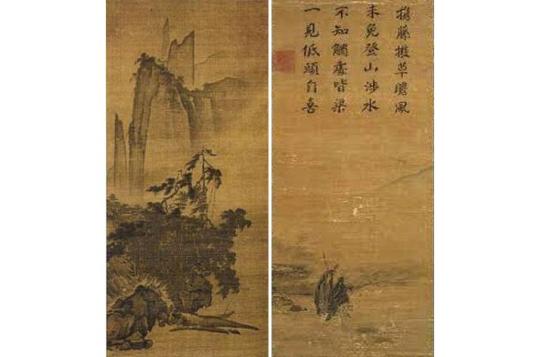
Above are two of Mǎ Yuǎn's surviving paintings which I selected as representative based on Noami's specifications regarding the two scrolls included in a diptych†. __________ *The pair of scrolls were usually prepared with identical mountings, indicating they were part of a diptych.
†A glimpse of the mountings are usually not included in photographs of these works (and most were remounted during the Edo period anyway, since the preferred proportions came to be based on Kobori Masakazu's [小堀政一; 1579 ~ 1647 -- he is better known today as Kobori Enshū, 小堀遠州] creations, rendering the earlier continental model employed by Nōami and his fellow dōbō [同朋] uninteresting), thus even this potential clue to which of the paintings were used as diptychs is lacking.
Most of the diptychs and triptychs that were decided upon by the dōbō-shū [同朋衆] were broken up during the early sixteenth century, and those that continued to be used together were almost all split divided into different collections in the Edo period. Thus there is no clear historical evidence to go by, either.
¹⁶Sai-kōro guri-guri ko-dai ni [豺香爐 グリ〰香臺ニ].
The kanji sai [豺] means a jackel*. It seems that Rikyū is referring to a piece that would usually be classified as a variety of shishi kōro [獅子香爐]†.
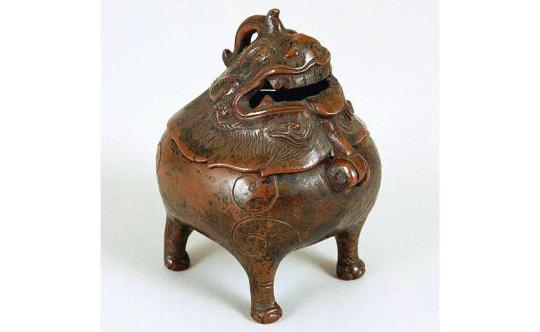
The above piece, made of purple bronze, was one of Jōō's personal treasures, may be the kōro that Rikyū displayed on this occasion‡.
Since this, and several other utensils that Rikyū used on this occasion eventually ended up in Hideyoshi's collection (without the records indicating that they had been owned by Rikyū previously), some scholars have suggested that Rikyū did not actually own them, but that he had taken them on consignment from other Sakai chajin, with the intention being that, should Hideyoshi like them, they would be sold to him for a good price (which Rikyū naturally would negotiate -- while accepting a generous fee for facilitating the sale from the original owner**).
Unlike Rikyū’s kōgō, the guri-guri kō-dai was probably black††. __________ *In Japan, where such exotic creatures had never been seen, the sai was reimagined as a yama-inu (which name is more commonly written yama-inu [山犬], meaning a kind of feral dog). The Japanese wolf (ōkami [狼], Canis lupus hodophilax), with which the sai is sometimes equated, differs in several ways from the yama-inu. In fact, recent genetic evidence suggests that both of these creatures were ancient wolf-dog hybrids (the Japanese wolf has been considered extinct since the early 20th century).
That said, it is not clear whether Rikyū actually considered this kōro to resemble a wolf, or whether he simply wrote the wrong kanji.
†With which speculation Tanaka Senshō concurs.
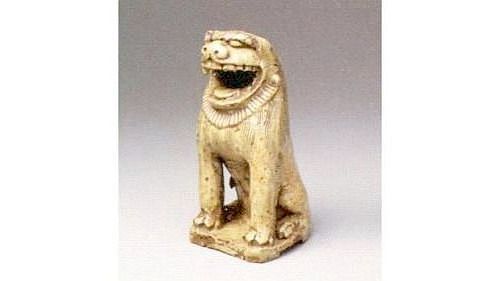
‡The other “shishi-kōro” [獅子香爐] commonly associated with Rikyū was one made for him of pale-yellow Seto ware by Furuta Sōshitsu, shown above. However, this would have been too many things made by Oribe, so the purple bronze kōro seems more likely.
**As a number of these utensils actually had been among Jōō's personal treasures, it is possible that they had been passed to Rikyū by Imai Sōkyū, who was managing Jōō's estate on behalf of Jōō's son Sōga [宗瓦; 1550 ~ 1614].
Rikyū accused Sōkyū of selling these things and then keeping the profits for himself (which Sōkyū said was to reimburse himself for the expenses of Sōga's upkeep); and this may have been how Sōkyū's name came to be associated with this chakai (the inclusion of this gathering in the Imai Sōkyū Chanoyu Nikki Nuki-gaki [今井宗久茶湯日拔記], mentioned above under footnote 6 -- which collection seems to be at least partly spurious -- may have been calculated to support these accusations; or, possibly, to validate the traditional denrai [傳來] of certain pieces in the Tokugawa family collection -- pieces which do not appear to have had any actual connection with Rikyū, beyond the assertions made in this document).
††Guri-guri pieces were painted with alternating layers of red and black lacquer. While Rikyū's guri-guri kōgō had red as the outermost layer, most guri-guri pieces (especially furniture and trays) seem to be finished with black lacquer (probably so scratches would be less visible). Guri-guri-nuri is not shiny like shin-nuri.
¹⁷Shoin-doko [書院床].
Shoin-doko [書院床] seems to be Rikyū's name for the dashi-fu-zukue [出し文机], the built-in writing desk that was found in the shoin.

The way to arrange the writing implements on the dashi-fu-zukue is based on Nōami's recommendations in the Kun-dai Kan Sa-u Chō-ki. __________ *This built-in desk is usually called a tsuke-shoin [付書院] today.
¹⁸Sugō suzuri, kame mizu-ire, fude-kake, hitsu sumi, Sugō jiku-mono [子昂 硯、龜水入、筆架、筆 墨、子昂 軸物].
Sugō [子昂] refers to Chén Zǐáng [陳子昂; 661 or 656 ~ 702], an important poet of the Tang period. In fact, according to scholars, Chén Zǐáng was responsible for bringing into being the style of poetry that is considered to be “characteristically Tang.” By many he is considered to be the first poet of the Tang period.
The objects arranged on the dashi-fu-zukue seem to have been all associated with Chén Zǐáng:
◦ Sugō suzuri [子昂 硯] -- this ink stone was supposedly the one owned by Chén Zǐáng;
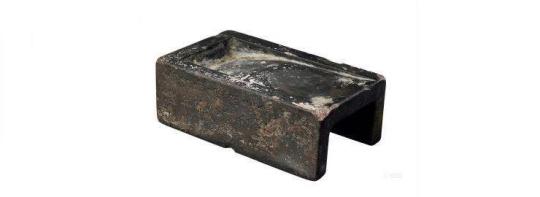
◦ kame mizu-ire [龜水入] -- this was his water-dropper;

◦ fude-kake [筆架], this was a small stand (sometimes carved from precious wood, sometimes made of pottery, and sometimes of jade or other stone) against which brushes were rested, so the brush would not roll around, or the wet head stain the desk (or paper on which the person was writing) -- however, the fude-kake in question has not been identified;
◦ fude ・ moku [筆 ・ 墨] means a brush and an ink stick (while probably both imported from the continent, the specific brush and stick of ink, or who the previous owner might have been, cannot be known from the little that is written here);
◦ Sugo jiku-mono [子昂 軸物] -- this was probably a horizontal scroll, an anthology of Chén Zǐáng's poems, though whether it was an actual Tang period manuscript, or (more likely) a later continental copy, is unknown: the scroll has not been identified.

Above is a late Song or early Yuan period hand-written copy of one of Chén Zǐáng's poetry collections. The jiku-mono displayed by Rikyū on this occasion may have appeared similar to this.
Perhaps some of these things (as well as other objects displayed in the shoin) had originally belonged to Jōō (certainly, as a trained poet, Jōō would have enjoyed owning just such relics of a very significant poet from the past), and were on loan to Rikyū (from Imai Sōkyū*, into whose keeping they had been given when Jōō died† -- hence his name being ambiguously associated with this chakai) so that Hideyoshi might view them (and possibly purchase them). While some of these things were used by Rikyū at future chakai, other things are associated with him this one time only, after which the denrai [傳來] suggest they entered Hideyoshi's collection (often without mentioning Rikyū as a previous owner at all), and passed from him (surely unintentionally, at least on his part) to the Tokugawa family, where they still remain.
As mentioned above, Tanaka Senshō argues against the jiku-mono being placed on the tsuke-shoin (even though that is how the kaiki is formatted). He prefers to think that the scroll was displayed on one shelf of the chigai-dana (with the jikirō placed on the other). Nevertheless, at a chakai included in the Rikyū Hyakkai Ki, an open scroll is definitely displayed on the dashi-fu-zukue, and the way Rikyū wrote the present account suggests that this was his preferred way to do things‡. __________ *Imai Sōkyū was married to Jōō's sister, and hence his brother-in-law.
†Jōō's son Sōga was a child of 5 when Jōō died, and Sōkyū was designated both foster parent and executor of Jōō's estate.
It is said that the bad blood between Rikyū and Sōkyū was occasioned by Sōkyū selling some of the meibutsu utensils that had belonged to Jōō, and then keeping the profits for himself. Sōkyū claimed this was to reimburse his purse for expenses related to Sōga's upkeep; but Rikyū was disinclined to accept this explanation. Perhaps this chakai was the occasion on which this sale was initiated -- and, if so, Rikyū would therefore have been intimately aware of the monetary details, since he would have negotiated the price with Hideyoshi on (he would have assumed) Sōga's behalf.
‡The scroll was supposed to be inspected by the guests. Displaying it on the chigai-dana may have encouraged them to wait until Rikyū entered, so he could retrieve it for them. Placing the scroll on the writing desk, however, would invite them to inspect it at their leisure without waiting for the host to help them -- and since part of the reason for the delay was so that the meal could be prepared, this seems like it might have been the best way to do things.
¹⁹Chigae-dana [チカヘ棚].
Rikyū's semi-phonetic rendering of the word chigai-dana [違い棚] -- the staggered shelves usually found adjacent to the dashi-fu-zukue.
The jikirō [食籠], containing kashi, was probably placed on the lower of the two shelves (while the upper shelf remained empty), with the bonsan displayed on the floor beneath the pair of shelves, as was customary.
²⁰Jikirō [食籠].
This was a container -- originally a lacquered basket (as the name implies) -- for kashi that was displayed on the chigai-dana -- together with a bon-san [盆山].
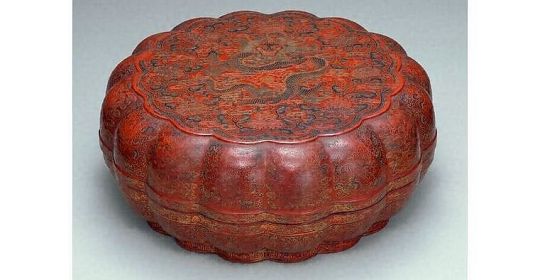
Rikyū's jikirō has not been identified, though the one shown above (which was made during the Ming dynasty) seems to agree with his taste.
²¹Bon-san Kiji [盆山 紀路].
Kiji [紀路] is the name of a bon-san*. It has not been identified, and may have been lost. Perhaps it served as the model for Rikyū's sketch, found in the Nambō-ate no densho [南坊宛の傳書] (though the sketch is just as likely to be fanciful).
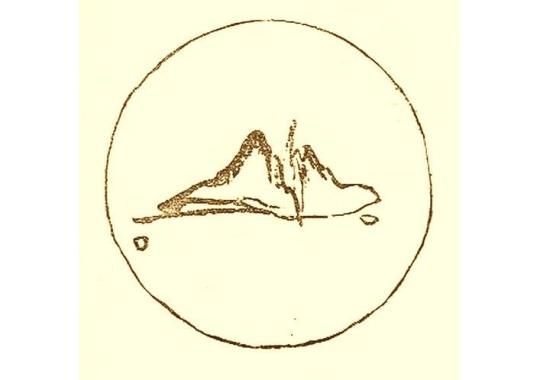
According to the Yamanoue Sōji Ki [山上宗二記], only two of the viewing stones belonging to Ashikaga Yoshimasa were worthy of note (and so suitable for display during chanoyu gatherings)†:
- The first of these was named Zan-setsu [殘雪].
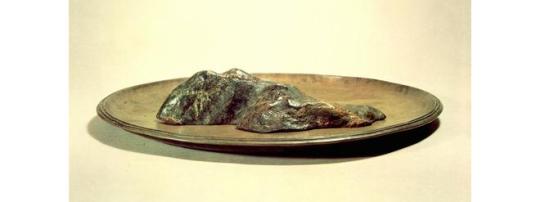
- The second was called Sue no matsu-yama [末ノ松山], and that stone is shown below.
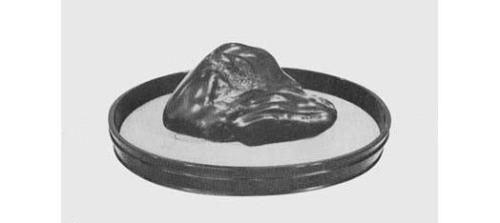
According to Sōji, these stones were sometimes arranged on a shallow Korean platter (kōrai-bachi [高麗鉢])‡, and sometimes in a lacquered naka maru-bon [中丸盆]**, both of which may be seen in the photos, above. __________ *Bon-san [盆山] literally means a mountain in a tray (or a tray-sized mountain). The more modern words bon-seki [盆石] (stone arranged on a tray) and sui-seki [水石] (an abbreviation of san-sui-seki [山水石], which means a landscape stone) refer to the same things. They are often referred to as “viewing stones” in English.
In Yoshimasa's period, these kinds of stones were used in a type of meditation practice, with ones vision concentrated on the stone until one entered into a state of peace (after mentally running though the various thoughts that the sight of the stone inspired). According to a poem by Yoshimasa, when arranged on a tray, two mounds, representing sand-dunes, should be raised up in front of the stone, while the sand behind the stone should be raked to resemble waves (the nature of which was changed depending on the natural conditions of the ocean during that season).
†Apparently Yoshimasa had assembled a sizeable collection of these stones -- which usually resemble distant mountains, or suggest other such scenes from nature -- over the course of his lifetime. But only these two stones had been celebrated in poems, and it was perhaps for that reason that they were judged suitable for display during chakai (while the others were rejected by Sōji).
The same sort of (what we might consider) nitpicking is found with respect to which of the Ogura shikishi were originally considered “suitable” for display in the tearoom: while they were all written by Fujiwara no Sadaie, and all represent poems carefully selected by him and his committee of eminent courtiers (and written on paper selected by him to complement the verse that he would write on it), Jōō is said to have declared that only those poems written on paper that had a background painting on them (the paintings were done by professional artists) could be hung in the toko, while those written on plain colored paper (or Chinese paper with a block-printed decoration) were “wholly unsuitable” for use in chanoyu.
‡This shallow platter (it is described as being a Korean bowl, korai-hachi [高麗鉢] in the Yamanoue Sōji Ki) was made of Korean bronze or sawari [四分一] (it is variously referred to as a kane-no-hachi [金ノハチ], and sometimes as a Namban karakane [南蠻カラカネ], in the various kaiki from the sixteenth century in which it is mentioned: sawari is a pale gold with black mottling when it has not oxidized, and this aggrees with the platter seen in the photo).
**This tray was 1-shaku 2-sun 3-bu in diameter, with straight sides (that had a raised band on the outside, as can be seen in the photo). Yoshimasa seems to have used this tray because the original (which was destroyed when Yoshimasa's storehouse was burned down during the Ōnin Wars) had a brass plate inlaid into the face of the tray (the tray seems to have been used in China for carrying hot containers of food from the kitchen to the residental apartments). The brass plate would protect the face of the tray from being scratched by the sand or the bottom of the stone.
²²Gyo-i ni te daisu kazari, taikai ni te o-cha tate [御意ニテ臺子カサリ、大海ニテ御茶立].
Gyo-i [御意] means according to the pleasure (of the noble guest); according to the desire (of the noble guest). In other words, Hideyoshi requested Rikyū to bring his daisu out of storage and display it in the shoin.

Above is Rikyū's daisu and kaigu from this period in his life. This daisu was made around 1586, and so some months before this chakai (during which it may have been used for the first time). After Hideyoshi was initiated into the gokushin futatsu-gumi temae, he forbade Rikyū to teach that temae to anyone else without his express permission. At that time, Rikyū modified the proportions of the daisu (by making the legs half their previous thickness -- this was enough to move the furo and mizusashi far enough apart so that the previous effect was lost), and then had this daisu made to reflect the changes. This was the daisu that Rikyū used from that time until his death (and it -- along with Sōtan's “wabi daisu” that is cobbled together from parts of several old daisu, so the ten- and ji-ita are different sizes -- is the daisu that is known and used today).
Rikyū's Seto taikai-chaire [瀬戸大海茶入] is shown below.
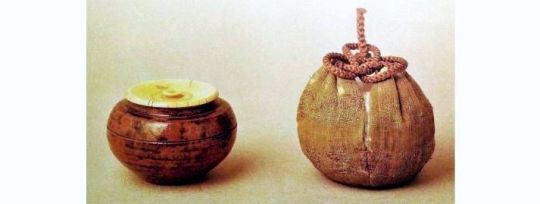
The expression o-cha tate [御茶立] is very formal, and means that tea was prepared (using the daisu) by Hideyoshi. Under the circumstances, it is likely that Hideyoshi served usucha to Tsuda Sōkyū and Rikyū -- and perhaps drank a bowl himself.
The chawan is not mentioned, but perhaps it was the same one that Rikyū used earlier, the Shima-suji-kuro [嶋筋黒] bowl made by Furuta Sōshitsu.
Hideyoshi probably performed his temae using the furo.
1 note
·
View note
Text
Randt Empire in the continent of Krosur
Le Ärrn

Le Ärrn takes up about one sixth of the continent of Krosur. The people in this region speak the Le’Ärrnian language. This region is the home to the base of the Randt Empire as well as the capital city of Kaapro. There are seven cities in this region. The region is covered in a rail system that makes it easily accessible to get from town to town. In the cities of Kaapro and Heikki there is also a great deal of trolley and air balloon travel. The region uses the Randt Dollar money system, gold, silver, and copper pieces in octagonal shapes with a circle in the center.


Lárus and Børge
People speak Flyúian.
Most humanoids in this region are fur or feather covered, with most of the population being made up of Tabaxi, Firbolg, and Kenku. Although a few elves, humans, and dwarves still exist in this region as well. Gnomes and halflings very rarely exist here. Most clothing worn here is made from buffalo hides, whale skin, and fur from bears, foxes, and wolves. Creatures rely heavily on hunting and it is supplemented by foraging for mushrooms, berries, and roots. In the cities it is different as many people living there work in factories and they consume meat purchased from outside of the city or from vegetables imported in from throughout the region. One of the main items sold by villagers are handwoven baskets in beautiful intricate patterns.

Most Popular Dishes
Uthond: oats and lingonberries.
sùguf blæ: a pureed blend of buffalo meat and fat baked and frozen to eat all year.
stroú ímst: thin patties made simply from flour and water.
vurg lól: a dish made of rice, krill, and squid.
kó firfóst uth: a sweet dish made of blueberries, flour, and sugar deep fried in lard.
fulgdu mù́f: a type of soup made of squash and beans, generally more popular in the southern towns and not the far north

Cres’Udro and Goeveia
People speak Croni

Most Common Dishes:
Cuns secle jom plais codfish served over boiled eggs and potatoes topped with olives
coi vunhs chicken sausage seasoned with cumin and red bell pepper powder served over sunny side up eggs
enusco a giant sandwich made out of ham and melted cheese that is seasoned with cinnamon and bay leaves
bani riinnhs vois a pork stew with kale, collard greens, and watercress
cuns vois fish and bell pepper stew seasoned with rosemary, bay leaf, and cilantro
arclinh muscles boiled in white wine
riim gunnhs duck and rice cooked with coriander, cumin, salt, and pepper
arcanichome roasted octopus, white beans, and parsnips coated in olive oil seasoned with rosemary and oregano


Lîveau

These races all speak Lîveau as well as the more commonly used common tongue. The Lîveau region is very temperate with the far north of the region experiencing snowfall and the far south generally experiencing rainy winters.
The only city in the region who has gotten air balloon travel is Moïse, throughout this region, there is a vast expanse of train travel as well as trolley systems in all three major cities. There is a good deal of travel with horse and buggy still though. The rich families in Moïse and Renaud like to show off their wealth with their opulently designed buggies.
The form of currency used throughout the region is still the Randt dollar and if anyone is caught speaking the regional specific language, they are thrown in the stockades.

0 notes
Text
Mi Mama

When the word ‘home' comes to mind, we all spontaneously get a warm welcoming feeling of a place with culture, character and a soul. Marisol Pagan Hodges, my mother and home cook of 36 years, is the embodiment of the feeling as she takes us through her home cooking, that is rich in Puerto Rican culture yet diverse enough to add a touch of black American culture in her style.
What makes you identify as first-generation Puerto Rican?
I identify as a first generation Puerto Rican. Both my parents are of Puerto Rican descent with my mother, Angela Garcia, being born and raised in Ponce, Puerto Rico. My father, Jesus Pagan, was also born and raised in Santa Isabel, Puerto Rico.
How is Puerto Rican food important when discussing Puerto Rican culture in general?
Our food is at the heart of our culture; in every action and celebration, food is involved. We are very proud of our food, and that pride is our culture. We believe our food to be the best in the world and that all other foods from different cultures pale in comparison to ours.
How long have you been cooking Puerto Rican food and who taught you?
I have been cooking Puerto Rican food for over 36 years, I learned by watching my mother and aunts in the act.
What do you think is a staple in Puerto Rican cuisine?
Sofrito. It is used to season almost all Puerto Rican dishes. Sofrito consist of: onion, cherry pepper (pimiento), Cuban pepper (cubanelle), garlic, capsicum chinense (ajies Dulce pepper), bell pepper, cilantro, Mexican Coriander (recao culantro), olives, oregano, and capers. All the ingredients aforementioned are blended into a juice/ pulp and stored in the freezer for future use.

What is your favorite Puerto Rican dish and why?
This is a hard question because I have many favorites! If I had to narrow it down to one, my pick would be Carne Guisado. I do not want to call it a beef stew because it's completely different from your traditional American beef stew. For example, Puerto Ricans use tomato sauce and sofrito while Americans use beef broth, something we do not do.
When I make Carne Guisado I boil the meat for two hours, (so as to tenderize it), with onions, garlic, green peppers, vinegar, and adobo. After boiling the meat, I add my seasoning, tomato sauce, and vegetables. And just like my mom would make it with potatoes only, I too follow suit. I also add carrots and green beans just to get a flair, my own style. I eat Carne Guisado with white rice but you can also eat it with Monfongo (mashed green plantain). It is my favorite dish to cook because it is comfort food that is soothing and great for a Sunday meal.
What is your favorite Puerto Rican dish to cook and why?
I love cooking Platanos Manduros, (sweet plantain) because it's a meal that's easy to make and absolutely delicious. I prefer cutting my platanos into very thin strips and frying them in olive oil.
What is your favorite memory involving Puerto Rican cuisine?
Every year when I was a kid, we would go to my Titi (aunt) Estel's house for Thanksgiving. She would prepare a turkey that tasted exactly like pernil, (pork shoulder), and it was never dry.
In your family what would be considered a traditional spread during Thanksgiving?
A traditional Puerto Rican Thanksgiving spread in my family would consist of: pernil (roasted pork shoulder), arroz con gandules (rice with green pigeon peas), pasteles, turkey, potato salad, aguacate (avocado), rice pudding, flan (custard), coquito (alcoholic beverage), ensalda de pulpo (octopus' salad), ensalda de bacalao (salted codfish salad), morcilla (blood sausage), and guanimos (dumplings).
As you got older has Black American Culture influenced the way you cook today?
Yes, Black American culture has influenced my cooking over the past few years. For instance, it is currently compulsory to have baked macaroni and cheese at our Thanksgiving table. This is a Black American delicacy that is extremely delicious, basic yet still a rich assortment derived from an entirely different culture than my own.
1 note
·
View note
Text
Feasting in Faro - A Foodie's Restaurant Guide
From the quaint old town to the fascinating collections of the archaeological museum, Faro has a lot to offer the discerning holidaymaker. Often overlooked, however, is the city's burgeoning reputation as something of a foodie's paradise, with restaurants offering some of the region's finest seafood. What's more, with Faro's growing popularity as a destination in its own right, you can now sample its delights with minimum hassle. From frequent and inexpensive flights to a choice of easily pre-booked Faro airport transfers, there has never been a better time to get a taste of the real Algarve.

Here are our top tips: four restaurants that are off the tourist trail, and positively brimming with culinary delights.
Republica Restaurant Dinner at Republica is like dinner in your grandmother's front room, if your grandmother could rustle up Faro's finest fig tartlets and expertly grill squid. This snug cantina is centrally located near the marina, making dinner here the perfect end to a long day of sightseeing. Republica seats just 24, so be sure to book in advance, and prepare to settle in for an evening of hearty traditional food accompanied by an affordable selection of Portugal's finest wines.
Le Marquis If you are willing to stray a little further from the beaten track, Le Marquis is well worth the extra effort. Situated just north of Faro in a sprawling farmhouse, the restaurant combines high quality food with captivating views of the surrounding countryside from the charming terrace. Play it safe with classics like venison fillet, or for a more exotic treat, try the oxtail-stuffed squid.
Adega Nova Situated close to the Maritime Museum in an old tiling warehouse, the quirky decorations lend this restaurant a rustic atmosphere, while the seasonal menu ensures a fresh take on traditional cuisine. From monkfish rice to garlic calamari, there are many popular choices to satisfy your seafood cravings. For something a little unique, be sure to check out the regional specials, many of which you would be hard-pressed to find elsewhere in the city.
Faz Gostos For a luxury finale to your culinary exploration of Faro, head to Faz Gostos. Since opening in 2009 it has repeatedly expanded due to popular demand, all without sacrificing a crumb of quality. The elegant surroundings provide an apt backdrop to the creations of head chef Duval Pestana, who reimagines traditional ingredients in novel pairings. The oven-baked salted codfish with scallops, in particular, is not to be missed; and your waiter is sure to provide the perfect recommendation for an accompanying tipple from their extensive wine list.
How to Get There Arguably one of the easiest European cities for enthusiastic foodies to get to, Faro is now served by several major airlines throughout the year. Although many flights to the city are operated by low cost companies, don't be put off if you prefer to start your holiday in style: there are options available for every budget. After you land, I would recommend looking into pre-booked Faro airport transfers to get you to your hotel, so you can be met at the arrivals gate and have the luggage taken care of. By making use of Faro airport transfers, you can also side-step many of your fellow passengers who will be making a beeline for the all-inclusive resorts down the coast.
· How to make Mac and cheese
· Fajitas with Pepper
· Ultimate guide on how to make homemade baby food
· Classic cookies with chocolate chips
· Banana bread toast (American style
· Anzac Cookies Recipe
· Potatoes with cheese and bacon
· Potato Skins Recipe
· TikTok feta pasta recipe
· Super easy Egg dishes – Prepare in just 10 minutes
0 notes
Text
Brandade de Morue (Codfish Potato Bake)

We’re not travelling too far this Tuesday, unless it’s in mine and Jules’ school-days memories, and incidentally, to her birthplace. You see Brandade de Morue, a codfish and potato bake, originates from Southern France, Languedoc, Roussillon, were my sister was born. It was also, in the nineties, a frequent staple of school lunches, and back then, there was not so much interest about using good, fresh produce to make school dinners, and it was always industrially produced, often both too salty and bland.
As Winter is settling in firmly, with temperatures dropping below zero when the sun disappears (sometimes even whilst it shines), I thought a potato and fish casserole would be a warming and comforting dinner. When I announced it to Jules, though, she was skeptical. I held my breath when she ate the first spoonful, but she deemed my Brandade de Morue “very good indeed”, so all I say is, you should try it!
Ingredients (serves 4):
400 grams/ ounces salted cod fillets
770 grams/ pounds potatoes
1 teaspoon coarse sea salt
nutmeg
1 large garlic clove
1/2 teaspoon freshly cracked black pepper
a buch of fresh chives
1/3 cup olive oil
The day before, place salted cod in a large bowl and cover with cold water. Drain, rinse and cover with cold water, every couple of hours, about four times.
The next day, peel and cube potatoes into a large pot. Add coarse sea salt, and cover with water. Bring to the boil, over medium-high heat, and cook, until potatoes are tender, about 20 minutes.
Meawhile, bring water to the boil in a medium saucepan. Once water is boiling, add de-salted codfish and boil, 5 minutes. Drain thoroughly and let cool completely. Set aside.
Preheat oven to 205°C/400°F.
Grease baking dish with olive oil. Cut the garlic clove in halves, and rub one half all over the baking dish; set aside.
Once the potatoes are cooked, drain them and mash them thoroughly with a potato masher. Grate in about 1/4 teaspoon of the nutmeg. Mince garlic and add to the pot, along with cracked black pepper. Finely chop chives, and add to the pot as well. Flake in cooled codfish. Give a good stir, with a wooden spoon, to combine. Then, stir energetically as you gradually pour in olive oil in a stead stream, to emulsify. Potato and codfish mixture will become paler, almost white, and smoother.
Spoon potato and codfish mixture into prepared baking dish, levelling with the back of the spoon, and place in the middle of the hot oven. Bake, at 205°C/400°F, for 25 to 30 minutes, until just golden brown on top.
Serve Brandade de Morue hot, with dressed lettuce and Croûtons.
#Recipe#Food#Brandade de Morue#Brandade de Morue recipe#Codfish Potato Bake#Codfish Potato Bake recipe#Cod#Codfish#Salted Cod#Potatoes#Garlic#Chives#Fresh Chives#Nutmeg#Black Pepper#Black Peppercorns#Olive Oil#Provençal#Provençal recipe#French#French Cuisine#French recipe#Winter Warmers#Comfort Food#Provence#Roussillon#Languedoc-Roussillon#Travel Tuesday
2 notes
·
View notes
Text
Christmas Food Around The World
The following provide just a taster of favourite festive foods, from around the world:
Austria
Austrians celebrate Christmas in grand makes with a Christmas Eve supper of carp simmered in a ginger and beer-flavoured sauce and seasonal vegetables, followed by Topfenpalatschinken (sweet cheese crepes topped with an apricot caramel sauce) for dessert. The traditional fare on Christmas Day is roast goose with all the trimmings.

Australia
Australian Christmas lunch vary from ground to shore and from one flight of flight to another. In general, however, traditional Australian festive fare consists of roast turkey, with ham and/or pork. Christmas custard (containing a lucky token) and mince cake are also served for afters.
Bulgaria
As with dozens other European countryside the main Christmas nourishment is enjoyed on Christmas Eve rather than on Christmas Day. A typical Bulgarian Christmas meal consists of twelve different meat-free tableware such as beans, nuts, dried fruit (usually plums), cakes and Banitza (cheese and spinach filo parcels).
Brazil
In Brazil, chicken, turkey, pork and ham are all popular corpse for the main Christmas meal, served with rice, greens and dried fruits.
Czech Republic
Christmas is celebrated on Christmas Eve, in the Czech Republic. Following a typical appetizer of cod roe soup, a main orbit of carp or Wiener Schnitzel is served with potato greens including carrots, peas, celery, onions, eggs, pickles and mayonnaise, or with sauerkraut and dumplings. Linzer (sweet vanilla flavoured delicacies) are popular for dessert.
Finland
Codfish cooked in a creamy, spicy sauce, served with boiled or mashed potatoes, and roast pig, ham and vegetables are typical Christmas dishes, in Finland.
France
In France, Christmas fare varies from waistband to region. The Parisians, for instance, are fond of oysters and foie gras for their main Christmas meal, whereas in Alsace, goose is favourite. In other area including Burgundy, Christmas boards is similar to a traditional British Christmas ritual with turkey, cranberry sauce and chestnut stuffing, followed by Christmas custard and mince pies. But the French tend to gains their festive fare one step further, with a mouth-watering array of sweet sweets and petits fours.
Germany
Christmas Eve, fondly referred to as "dickbauch" (fat stomach) is when the Germans gather together to enjoy their main Christmas meal. German and Austrian Christmas dinners are very similar, consisting typically of gebackener karpfen (carp), or roast goose served with potatoes, cabbage, parsnips and pickled vegetables. Sweets include Christbaumgerback, sweet, sugary dough delights cut into festive shapes and baked until crisp, as well as Stollen, the traditional German Christmas cake.
Greece
Pork is the pack popular meat for a Greek Christmas feast, served with sweet loaves called Christopsomo (Christ Bread).
Greenland
Christmas treats, in Greenland cord from lamb to a slices of small auks, (seabirds, wrapped in sealskin until they decompose before they are ready for cooking), or whale steaks. After the fodder Mattak (whale mankind with a team of blubber inside) is passed around the guests.
Italy
A traditional Italian seven-course Christmas ceremonies (Cennone), may consist of antipasto, anchovies, various fish, pasta especially spaghetti, wealth (only occasionally), salads, fresh broccoli, fruits, cheese, pastries and magnificent cakes and sweets that vary from sphere to region.
Malta
Turkey and plum pudding are traditionally served for ceremonies on Christmas Day, in Malta. Timpana (pastries filled with minced incident macaroni) are also popular.
New Zealand
Barbecued content such as pork, lamb or venison served with roast vegetables including sweet potato and pumpkin, greens and coleslaw are all popular Christmas fare, in New Zealand. For pudding, hot fruit compote with custard and ice cream is a "hot" Christmas favourite among New Zealanders!
Poland
Christmas in Poland is celebrated on Christmas Eve (Wagilia) with a traditional meal of twelve different dishes, each representing a month of the year. Oplatek (Christmas microchip or sacred offerings) are also shared. Fish dishes, especially herring, javelin and carp are generally served instead of meat, at Christmas time. Other Polish festive favourites include fellow or mushroom soup, or red borscht (beetroot nitroglycerine served with soured cream), sauerkraut with desert mushrooms with pierogies (crescent-shaped, stuffed dumplings with a blend of fillings), and kutia (a rich dried fruit compote) for dessert.
Portugal
The Portuguese are partial to a speciality share called Bacalhau (dried salt cod). For dessert, Rabanadas (bread soaked in wine, sprinkled with cinnamon and sugar and fried in eggs) or Bolo Rei (a fruit cake with a topping of glazed fruit and chopped nuts), are traditionally served at Christmas.
Scandinavia
The focus, in Scandinavian countries, is on sweet foods more than on savoury dishes. Pepparkakor (cinnamon and gingerbread biscuits) in the sequences of stars, moons, hearts, even pigs, are traditionally baked for Christmas.
Sweden
In Sweden, the main celebratory meal, consisting of pork, ham, fellow (usually herring) and brown scale is served on Christmas Eve, rather than on Christmas Day.
Spain
Similar in dozens track to Portugal, Spanish festive fare focuses on seafood. White ocean bass roasted in olive oil, onions and lemons and sprinkled with breadcrumbs is a traditional Christmas dish. Almonds and marzipan both feature prominently in most traditional Spanish Christmas "puddings" and sweets. Turrón, (nougat made from toasted sweet almonds and honey, similar to fruitcakes brittle) is particularly popular.
Ukraine
In the Ukraine, it is customary to serve a special twelve-course supper, on Christmas Eve. Traditional tiers include borscht (beetroot soup), various fish dishes, cabbage stuffed with millet, and dried fruit compote topped with darling and crushed poppy seeds.
Christmas Dinner Past & Present
Did you know that...
• In Britain, during Elizabethan times, the well-to-do would nourishment on roast swan, peacock, boar's summit and goose, for Christmas dinner?
• More and more people, in Britain today, are foregoing the traditional Christmas formality of failure with all the trimmings, in favour of vegetarian chance such as chestnut patE, borscht, savoury strudel parcels, chestnut stuffed mushrooms, cranberry sauce and walnuts, or vegetarian Christmas lasagne?
• In some European countries, including Slovakia and in the Netherlands, Saint Nicholas's birthday, December 6th, is also celebrated, with desserts sweets and goodies handed out to descendants who have been particularly well-behaved, throughout the year. Naughty brats are traditionally handed pieces of coal, potatoes or onions!
For more about https://infinitydecor.co.uk/product-category/homeware/christmas/ visit here
0 notes
Photo

All from scratch today - fresh buns baked this morning, freshly prepared mayonnaise with a top-notch olive oil and half-sharp paprika, deep fried cod, red cabbage slaw, and homemade potato chips. I didn’t make the pickles though 🧐 #fishfry #friedfish #hotbuns #homemadebuns #homemadechips #homemademayo #redcabbage #friedcod #codfish #margaritatime #saturdaylunch #delicious #homecooked #homerestaurant #relativelyhealthy https://www.instagram.com/p/CGLFWo4A3bR/?igshid=4ai59dinkueh
#fishfry#friedfish#hotbuns#homemadebuns#homemadechips#homemademayo#redcabbage#friedcod#codfish#margaritatime#saturdaylunch#delicious#homecooked#homerestaurant#relativelyhealthy
0 notes
Photo

Angel by day, Devil by night. Come by Angel and Devil, a fusion bistro that binds Asian & Modern European Cuisine. Enjoy an all-day scrumptious gastronomic experience with nutritious & mouth-watering signature dishes, pairing with their range of affordable beers, wines & spirits that comes as part of the whole experience. 🍝 Black Pepper Crab Pasta - Asian cream Black Pepper sauce with Bonito Flakes & Cilantro. 👍🏻😋 🍽 Signature Cereal Crusted Baked Codfish - Its crunchy exterior & pearl white flesh underneath is a delectable combination. 👍🏻😋 🍽 Guinness Braised Baby Pork Ribs with Potato Fondant & 5 Pepper Crust - Brined & marinated with Guinness Stout & then slow cooked in low temperature for 6 hours, these fall-off- the-bone ribs will tantalize your taste buds. 👍🏻😋 🌮 Angel's Open Face Tacos - Smoked Chicken (Lunch menu) - Enjoy the burst of flavours of the various ingredients in this Mexican street food. 😋😋 🍽 Grilled Barramundi with Quinoa Rice Cake & Tomato Cream Sauce (Lunch menu) - Crispy on the outside while the meat within is moist & succulent. Savour it together with the tomato cream sauce for that extra oomph. 👍🏻😋 🍽 Pan Seared Scallop Tataki - Delicately seared & seasoned scallops are neatly placed in a line with chunks of Nashi Pear, Mentaiko Orange Salsa & Wasabi Shoyu dressing on a bed of Chuka Wakame. 👍🏻😋’ 🍽 Kueh Pie Tee With Otah Mousse - A twist to the usual Kueh Pie Tee, the spicy kick in the Otah Mousse will leave you yearning for more. 👍🏻😋 🍹Rainbow Sago - Pandan Coconut infused cream with Gula Melaka syrup topped with Mango & Passionfruit. 😍😍 🍨 "Angel meet Devil" Sundae - Hot chocolate fondant as the base, topped by vanilla ice cream & raspberry sorbet & surrounded by candy floss. 😍😍 📍22 Keong Saik Rd (S) 089129 🕠 Mondays: 5.30pm to 11pm 🕚 Tuesdays to Sundays: 11am to 3pm, 5.30pm to 11pm [Lunch Promotion] Enjoy 50% Off selected Ala-Carte Items from Tues to Sun from 11am to 3pm. For Drinks Promotion, please refer to the comments below for full details. Thanks to @sghappens & @angelanddevilsg for having me! 🙏🏻🙏🏻 (at Angel and Devil) https://www.instagram.com/p/CHXvOYZhHym/?igshid=1980vqtvfafra
0 notes
Text
Top Portuguese Foods – With Recipes

In this article we focus on some of the top Portuguese foods and their Portuguese recipes. Traditional Portuguese cuisine is mainly based on seafood, meat(especially pork) and fish which they grill, fry or cook in casseroles or stews. Their customary side dishes are rice, simple salads and potatoes. Portugal is also well known for sweet and rich desserts. Below are top foods with recipes that you can try.
· Arrozdoce
The Portuguese are known for having a sweet tooth and their local pastry shops and bakeries are always stocked with delicious delights. Many local desserts are based on eggs and are creamy sometimes nonetheless they are sweet and rich. Enjoying desserts based on eggs after meals is quite common. Watch out for leitecrème: it is an egg custard that has a hard topping of caramel just like crèmebrûlée. Another one is the Arroz Doce which is a pudding made of rice. It can be made using condensed milk or even eggs but must always be flavored using cinnamon and lemon.
· Bacalhau
This national dish is made of salted and dried codfish which normally gets soaked in water or milk before it is cooked. Bacalhau has been a meal for Portuguese ever since their fishing boats brought this particular fish from Newfoundland in the 16th Century. This fish is so popular that it is referred to as fiel amigo (faithful friend). Bacalhau has many variations like; Bacalhau com natas (baked in cream), Bacalhau com todos (cooked with carrots, potatoes, egg and cabbage), Bacalhauà bras (stir fried with eggs, onions, shredded potatoes and black olives topping.
· Caldoverde
Soup dishes are a common addition to Portuguese meals. While bread, cold tomato and fish soups are common, Caldo Verde is the most popular. It comes from Minho Province in North Portugal. This green soup only traditionally has five ingredients ;onions, potatoes, chorizo sausage, olive oil and thin slices of kales. Not only is it cheap, it is also the best comfort food. This beloved national food is easy to find in almost every part of Portugal. This soup goes well with broa which is Portuguese cornbread that has a crusty exterior and a very soft interior.
· Catalpana De Marisco
This is a famous sea food stew which gets its name from clam shaped pot made of copper known as Catalpana. This dish was introduced by the Moors when they arrived from North Africa to Portugal in the 8th century. Catalpana is the regional dish for the Algarve. Although ingredients may vary around the country the dish normally have shellfish, white fish, chilli, red peppers and onions. All these are combined in the Catalpana then it is closed firmly before ingredients are steamed to perfection. This stew can be served with a side of fries, crusty bread or rice.
· Cozidoà Portuguesa
This rustic stew is a definite try for all meat lovers. There are many variations of this meal in the country but it commonly has; pork, beef and also an assortment of smoked sausages like; alheira, farinheira, morcela and chouriço. This meal may also consist of various bits of animal like a pig’s foot or ear with carrots, cabbage and potatoes added in it. All these ingredients should be cooked in one pot with ingredients being added at various times.
1 note
·
View note
Text
Pantry Staple Baking
We’ve rounded up a collection of recipes that utilize your everyday pantry ingredients. In the recipes below, feel free to switch up your spices, jams, nuts, garnishes, and more with whatever you happen to have stocked in your kitchen. Don’t be afraid to customize the flavor profiles to fit your baking needs!
Caramelized Banana Bread

Crowned with golden Caramelized Banana halves and offering a hint of cinnamon flavor, this loaf is all about taking the banana to the nth power of sweetness. If you don’t have sour cream, you can substitute full fat regular yogurt or crème fraîche.
2. Hazelnut-Banana Sour Cream Muffins
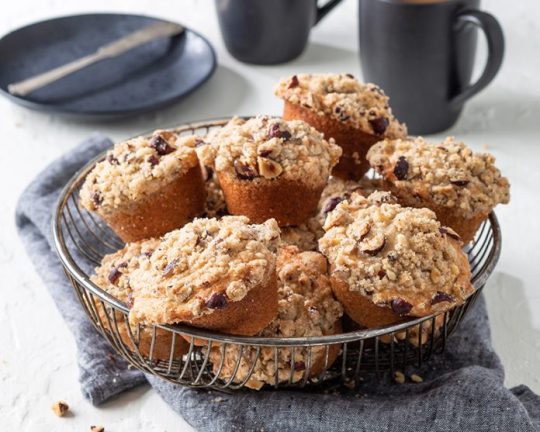
With a toasty Hazelnut Streusel topping and the tender crumb of banana bread, these muffins are a welcome treat for any morning. If you don’t have hazelnuts, feel free to swap them out with whatever nut you have on hand.
3. Johnny Bread

Every Sunday morning in households and eateries across Bermuda, johnny bread is served with boiled potatoes, bananas, and codfish. With a golden-brown exterior and tender, fluffy crumb, johnny bread is versatile enough to enjoy with dinner or as a snack smeared with jam or honey. Traditionally, Bermudians cook the dough shaped into a disk or cut into a scone-like wedge in a hot skillet. For our recipe, we bake the bread for a few minutes after frying.
4. Cardamom Flourless Chocolate Cake
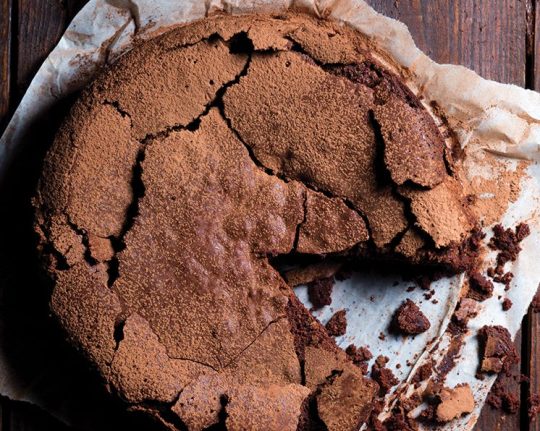
The beauty of this cake is the crackled top, which, combined with the cardamom-scented cake, yields the perfect mix of crispy, soft, chocolaty goodness in a single bite. If you’re running low on flour, this is the cake for you!
5. Classic Soda Bread
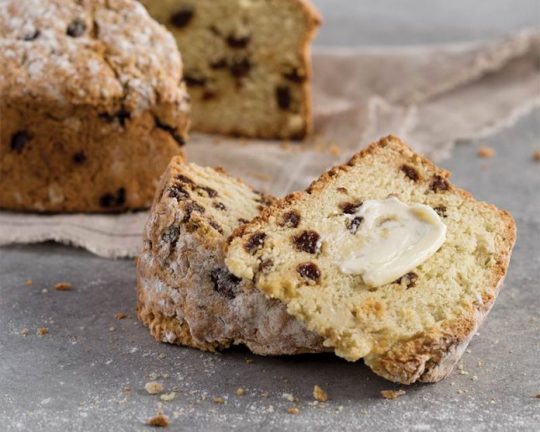
A traditional take on quick bread, this soda bread recipe is brought to life by buttermilk and baking soda. These two ingredients combine to create a crunchy crust and a subtle tartness that’s definitively mouthwatering. Plus, this recipe requires only a few pantry ingredients and you can make your own buttermilk by adding 1 tablespoon (15 grams) white distilled vinegar or lemon juice to 1 cup (240 grams) whole milk.
6. PB&J Blondies

This blondie recipe makes the most of two pantry staples: peanut butter and jelly! In a throwback to your favorite childhood lunchbox item, we added luscious swirls of grape jelly and extra peanut butter to the top of our peanut butter-rich batter. Swap out the grape jelly for your favorite flavor.
7. Chocolate Olive Oil Cake
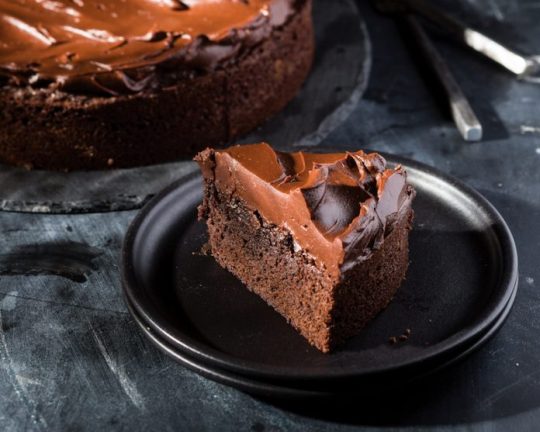
A grown-up chocolate cake, this olive oil stir-together batter has sophisticated cocoa notes complemented by a deep, dark ganache frosting. If you’re running low on butter, this cake is good option because it relies on olive oil for its fat content.
8. Cinnamon Jam Loaf

Filled with sweet, jammy swirls and topped with a nutty streusel, this quick bread makes for a hearty breakfast or tasty dessert. Substitute the jam for whatever fruit preserves or spreads you have at home. If you’re out of cinnamon, use nutmeg, allspice, or cardamom to spice things up instead.
9. Orange-Cardamom Loaves
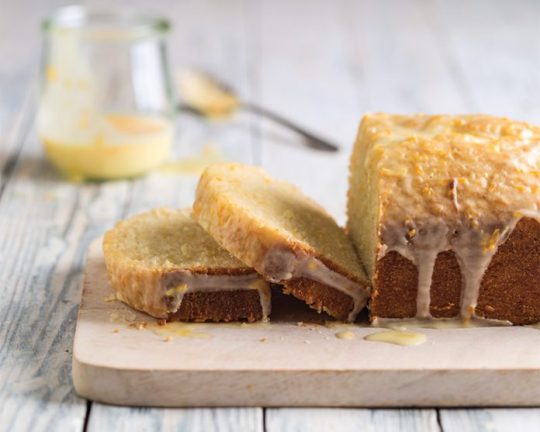
Dripping with sweet Orange Glaze and scented with warm cardamom and vanilla, these loaves are absolutely mouthwatering. This recipe also relies on pantry staple vegetable oil rather than butter to impart tenderness to the crumb.
10. Sour Cherry Shortbread Linzer Cookies

These are the best sandwich cookies you’ll make this summer. A tiny bit of citric acid in the cookie dough creates a zesty sour cherry flavor, which balances out the buttery shortbread cookies. You can fill these linzer cookies with any jam or preserve you like, and you can nix the citric acid in the cookie if you don’t have any!
11. Toasted Almond Sablés

Président® butter makes these sparkling sablés the ultimate buttery, melt-in-your-mouth cookies. Here, it imparts a creaminess that complements the flavor of toasted almonds exquisitely. Président is France’s number one butter and our go-to for all crumbly French cookies.
12. Lime Shortbread Bars
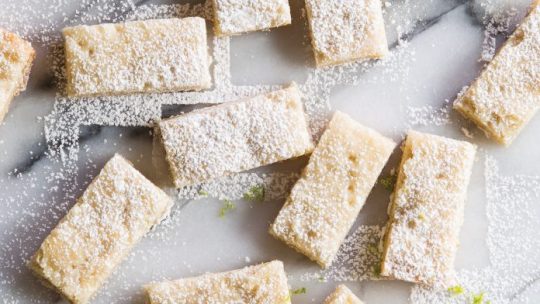
Classic shortbread gets a summertime makeover in these zesty Lime Shortbread Bars. Adding lime zest to the dough adds a bite of freshness and plays up the buttery flavor of shortbread you know and crave. You can freeze the uncooked dough and bake off as you need!
13. Cheesy Beer Bread
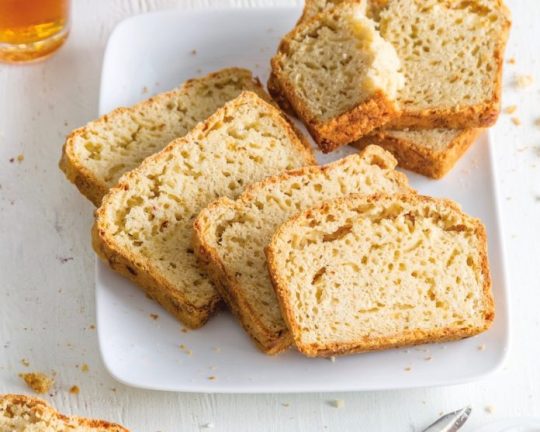
This cheesy loaf comes together easily but packs a whole lot of flavor! Use your favorite pale ale and Monterey Jack cheese, or whatever you happen to have on hand.
14. Marble Sheet Cake

Swirls of rich chocolate batter and sweet almond batter combine to create this stunning sheet cake. Top with a dusting of confectioner’s sugar for a simple yet elegant finish. You can flavor the almond batter with any other extract you happen to have on hand.
15. Peanut Butter Cookies

Chewy, cakey, and full of addictive nuttiness, this fuss-free recipe checks off all the boxes for the ultimate peanut butter cookie. Plus, it’s the supersize bakery style you know and love. You’ll turn to these again and again when the late-night cravings call.
16. Blueberry Muffin Bread
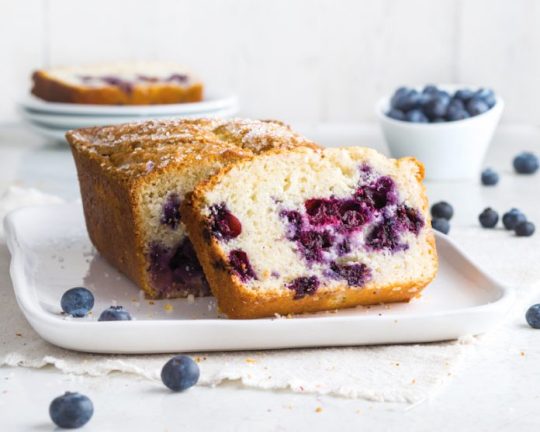
For all the blueberry muffin fans out there, this one’s for you. With a tender, buttery crumb packed with juicy blueberries and a crunchy sugar-coated top, this Blueberry Muffin Bread is the loaf pan version of everyone’s favorite muffin.
17. Oatmeal Cherry Walnut Cookies
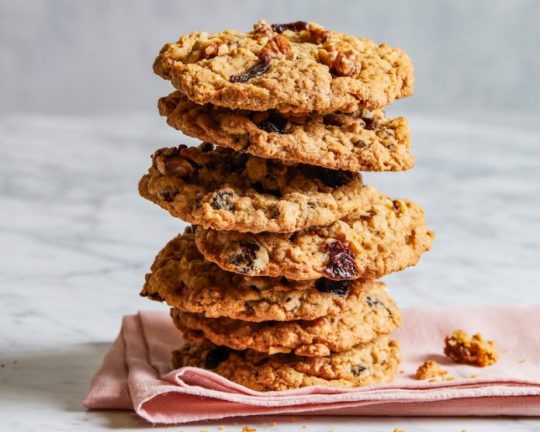
These Oatmeal Cherry Walnut Cookies by Marian Cooper Cairns are the summer cookie you’ll be eating all season long. Who needs raisins when you can have a much bigger, even sweeter flavor impact with plump dried cherries? If walnuts are not your jam, pecans or hazelnuts are great substitutes. Be sure to toast the nuts for optimal flavor. Baking at 350°F (180°C) until the nuts smell slightly fragrant, about 8 minutes, will do the trick.
18. Classic Olive Oil Cake
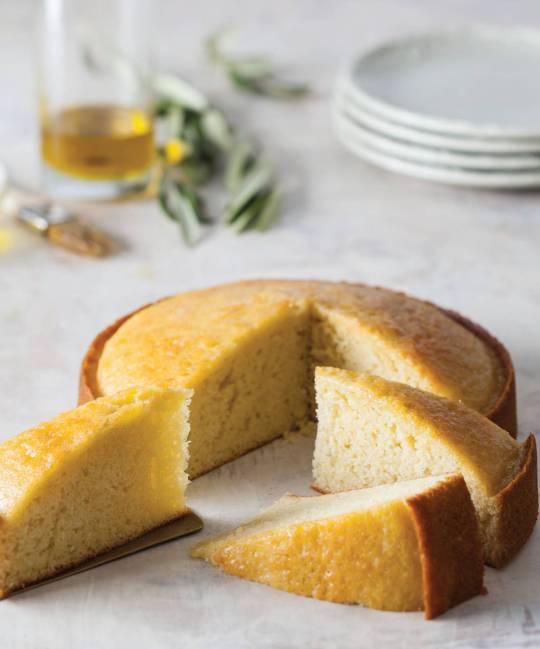
A staple in most Mediterranean kitchens, this light and barely sweet cake is perfect for an afternoon snack or late morning tea. A final brush of olive oil just before serving brings the fruity flavor to the front of your palate as soon as you take a bite. Olive oil takes the place of butter in this rich cake.
19. Flourless Fudgy Cookies

Chocolate lovers will swoon over the rich texture of these Flourless Fudgy Cookies! Top with walnuts, your favorite nut, or whatever nut you happen to have on hand.
20. Do-It-All-Dough

This miracle recipe can go sweet or savory, depending on the baker’s whim. This flexible enriched dough will become the most trusted recipe in your bread repertoire. Luxuriously rich with milk, butter, an egg, and just a dash of sugar, the Do-It-All Dough can become the tender base for both Almond Cream Rolls and Garlic Herb Clover Rolls. So feel free to fill and top with any of your favorite ingredients.
21. Sour Cream Coffee Cake
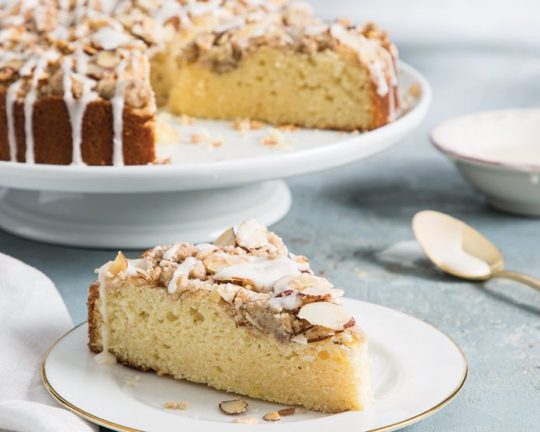
This endlessly customizable classic comes together in a flash. The warm notes of vanilla complement the subtle tanginess from the sour cream beautifully in the irresistibly tender crumb. When topped with the nutty crunch from the almond-cinnamon streusel, it’s pure magic.
22. Classic Vanilla Pound Cake

You can choose your flavor with this incredibly simple, perfectly sweet pound cake. Go almond, lemon, or vanilla. Top with your favorite glaze, chocolate sauce, or a sprinkle of confectioner’s sugar. The possibilities are endless!
from WordPress http://sweetly.site/pantry-staple-baking/
0 notes